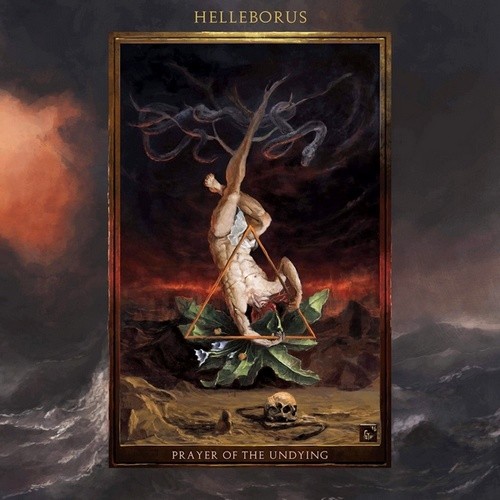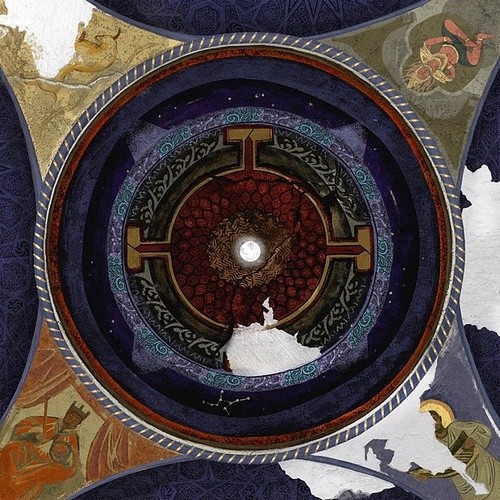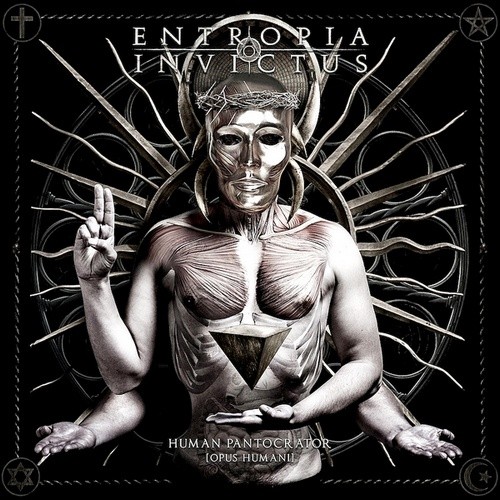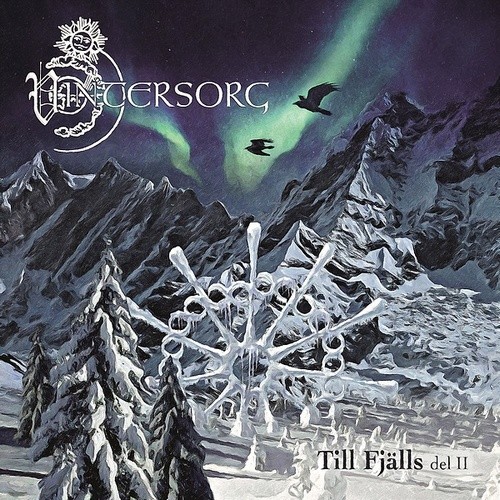(Our ally Gorger from Norway returns to our putrid neighborhood bearing gifts — four more underground gems from 2017, three of which we haven’t previously reviewed. To find more of his recommendations, type “Gorger” in our search bar or visit Gorger’s Metal.)
And so, a month did pass anew. That’s what you get when life finds its way of twisting and turning for a handsome young man. To the worse I might add.
Nah, who am I fooling. I’m neither young nor good looking. Fuck it. Time to drown ourselves in more tunes never before presented on No Clean Singing.
By the way, I’ve sunk to new depths, and enrolled with the herd of sheep. So for those who care to give a fuck, this cunt can also be found on Facebook now. With this self-advertisement I likely can’t get any lower, so let’s fire up the engines and soar into mighty metallic sceneries.
HELLEBORUS – PRAYER OF THE UNDYING (SINGLE)
Helleborus have been presented here on three occasions [editor’s intrusion: more than that], including in an interview conducted by KevinP, and an NCS video premiere. This summer they dropped a release in the form of a just 7.5 minutes long single. Not only did they forge while their name was still hot, they also made me ever so eager to hear more. My biggest appeal on the previous occasion was to correct the overly compressed production. We’ll get back to how this aspect is doing this time.
Prayer of The Undying is a single song clocking in at 7:26, and it may actually be the band’s best song to date! Not that I’ve heard everything through Prayer of The Undying recently, though. Just to mention it, the three singles the duo released in 2015 were all represented on the album (2016’s The Carnal Sabbath).
One thing is that the sound is better. The single ain’t generous with sonic dynamics, but it’s far from as compressed as the album was, and the clipping is by no means as evident, and the basic production sounds more glowingly infernal here. The music itself may have been more spacious and genre-wise unconventional, idiosyncratic, and boundless on the album. Highly respectable indeed. But personally, I’m nevertheless weak for this tight as a nun’s bum hell-fire.
Prayer of The Undying has got tighter musical reins, but the song has enough diversity in all its flaming splendor. In addition, the coherent whole is flanked by good but moderate melodic choices, and crowned by a rather melancholic, but also diabolically devil-may-care form of atmosphere. The vocals were quite damaged by clipping on the previous occasion, but this time the words shine of Lucifer’s wrath, along with nifty guitar works. The drums are also varied, but the amount of blasting appeals abundantly, at least to yours truly. A killer song, I tell you.
Prayer of The Undying was released independently on June 9th [editor’s intrusion: and previously reviewed here].
VIN DE MIA TRIX – PALIMPSESTS
Vin de Mia Trix from Kyiv in Ukraine play progressive funeral doom, offering one of the year’s longest albums. The band has been presented here earlier, as they were included in a New Year Greeting and a Doom Quiz, both courtesy of Comrade Aleks.
Palimpsests * is a concept based on multicultural commonalities; Stories, legends, and tales, as well as shared customs and practices that appear to be similar despite various beliefs or geographical, cultural, and ethnic differences. A duration of about 1 hour and 38 minutes makes Palimpsests just short of 100 minutes. If that sounds insurmountable, the physical edition is naturally a double-album, where each part lasts for about 49 minutes.
The music is mostly calm and fluid like a peaceful stream of clean water. A trickling mountain stream reflecting the shining rays of sun from a bright blue sky and the deep green lush vegetation along the river bank. The river winds, though, create turbulent currents and swirls, nuances that distort and wipe out the reflections. It strikes rocky obstacles that are unable to hinder the flow, but that throw the water masses around and shuffle the composition and relative location of each drop of water.
Especially Pharmatos and Noe offer a bit of drama, but despite a few harder sequences and sporadic guttural vocals, Palimpsests is a rather calm and pleasant work. It contains a relatively high quantity of clean vocals, plus clear bass strokes and sequences of acoustic plucking among others that help prevent everything from sounding like a steady stream. Although the creek floats calmly, it doesn’t just hiss in a hushing manner. It burbles and gurgles comfortably.
Among the quartet’s members, there are two seemingly fresh names, in addition to vocalist Andrew Tkachenko from the wonderful Human Collapse and bassist, second vocalist, and acoustic guitarist Alex Vynogradoff from Kauan.
Damon Good from Mournful Congregation and StarGazer has been responsible for mixing and mastering, and the sound is in line with Vin de Mia Trix‘ high ambitions, helping to enhance Palimpsests‘ meditative impact. The album is available at an optional price and is recommended whether you want a one and a half hour time-out in the hammock under the shady groves, whether you’re a traveller hiking forests and peaks, or if you’re only a fairly ordinary sofa lover that lets five minutes on the couch grow into a hundred.
Palimpsests was released by Hypnotic Dirge and Cimmerian Shade on May 31st.
ENTROPIA INVICTUS – HUMAN PANTOCRATOR (OPUS HUMANI)
Entropia Invictus is the only band here that’s entirely new to NCS. About time, then, to do something about it.
One of the aspects I value most in symphonic extreme metal is the diversity that exists. There’s lots of extreme metallic expressions, and there are dozens of classical eras bearing diverse characteristic to find inspiration in. This provides a fertile ground for a myriad of distinct metallic-orchestral alloys to flourish. Calling it a genre of its own is thus misleading, but if you allow some generalization, it’s a genus with enough elbow room for everyone to find their own expression whilst avoiding generic lack of distinct creative ideas.
The French quartet Entropia Invictus simply called themselves Entropia from 2006 to 2015, and released two albums and two EPs during that time. I can’t say for sure whether the change of name is due to a change in style or not, but according to Encyclopaedia Metallum, the band used to play melodic black/power metal. Today, however, the quartet plays black/death. A quick listen to random parts of the band’s previous album, Black Drop in Clear Water (2012), would suggest that they’ve become a bit more extreme.
The band’s black/death is presented in a complete hybrid with dramatic symphony and opera, and their third album, Human Pantocrator, requires time to sink in. The music has a theatrical structure that leads my mind towards last year’s masterpiece by Winterhorde. Associations to everything from Septicflesh and Carach Angren to Hortus Animae also surface.
The album has a lot of sound at almost any time, but with dynamic mid-tempo and abundant substance, it never feels particularly intense. The music continuously alternates in tempo and expression. Extreme metal, opera, waltz, and classicism make for a seamless backbone in the band’s work, but the French also mix in other sources of inspiration if beneficial. That elements of Asian folk music should slip so gallantly in might not be very strange, but not everyone is bestowed with the imagination to even come up with such a concoctive idea.
The band’s drummer has taken care of recording and mixing, and Brett Caldas-Lima (Kalisia) has mastered the work in his Tower Studio. The sound is compressed, but clear, clean, and quite rich. The sound could have been more organic and juicy, but the sound suits and conveys the material’s dramaturgic and bombastic touch more than enough. Entropia Invictus have created a very well-composed symphony.
Human Pantocrator (Opus Humani) was released by M & O Music on February 24th.
VINTERSORG – TILL FJÄLLS, DEL II
Vintersorg have obviously been mentioned on NCS before. Andy Synn has presented reviews of both Naturbål and Orkan. To keep up with him, I’m applying a lengthy approach here. (Just to clarify: that was a joke.)
Having left earthly nature in favour of the stars, taking a closer look at the universe through technical approaches to progressive Sci-Fi related metal, before anew approaching Mother Earth through three of the four elements, Andreas “Vintersorg” Hedlund has now returned to the nature from whence he once came.. The circle is complete. Andreas didn’t intentionally set forth to create a sequel, but when natural inspiration led him back to wild nature and rugged terrain under snowy peaks, he simply followed his heart and the call of the grey summits.
Under normal circumstances, it’s normal to compare a new work to the previous one. In this case, it feels more natural to compare with the original, Till Fjälls (1998). However, to compare quickly with Naturbål (2014), it feels in many ways as if Vintersorg has come home this time. Naturbål was good, but the folk-tuned melodies we find here, simply are Vintersorg.
Comparing objectively with Till Fjälls (meaning To the Mountains) isn’t entirely easy. Long-time fans of the debut, through almost two decades, have their own irreplaceable relationship to it, and Del II (Part II) will never take over the throne. This year’s album nevertheless follows in its ancestor’s spiritual footsteps, and Del II of course sounds more professionally conducted. Newer fans may even put the prince above the king on the hill.
Discussing each of the nine new songs (and four elder that we’ll return to) would be rather excessive, but let me at least mention a few. The album opens with melodic black elements before the melodies reveal majestic nature and a mighty calving glacier threatened by climate changes. Jökelväktaren (The Glacier Guardian) is a loosely based sequel to the song Jökeln (The Glacier), and contains plenty of melodic folklore, while the next song with becoming orchestral spices also has themes relating to ice and snow.
After tumbling down the hillside in the avalanche called Lavin (Snow/Landslide), Fjällets mäktiga mur (The mountain’s mighty brick-wall) follows as a sequel to the title song from the debut. Vinterstorm (Winter storm) must also be mentioned. After a bit of orchestral drama à la Grieg, a storm is brewing, blowing up to epic proportions with solid folk tunes in the gusts. As in many other cases, this looks promising for those who enjoy a good Swedish sing-along in the refrain.
During the formation of the band, some 11 years ago, in the transition from the band Vargatron to Vintersorg, the EP Hedniskhjärtad was written. A number of other songs and ideas were composed during the same period, without getting past the writing phase. Andreas came across an old recordable tape labelled “Vargatron rehearsal” in the basement and found that the time was adequate to wipe dust off these songs. The raw material was reworked and recorded as a bonus EP titled Tillbaka till källorna (Back to the sources). While Till Fjälls, del II lasts for about 50 minutes, the EP clocks in at approximately 25 minutes. Ergo, we’re served a lavish meal this time.
From the beginning, this was a one-man band, but guitarist Mattias Marklund entered the band for the third album, and the crew has since been stable. Vintersorg has never had a drummer as far as I know. The drums have primarily been programmed by Andreas, who has also handled bass, keyboards, and extra guitar in addition to his acclaimed vocals, of course. Simon Lundström who did session-bass on Naturbål (Nature-camp/bonfire) is now a permanent member. It can also be mentioned that Cia Hedmark, who sang a bit on the debut, also adds some vocals to the song Vårflod (Springtime flood, or Freshet).
I’ve always considered Ödemarkens son (Son of the Wilderness) (1999) to be a very worthy sequel to the debut, and with Till Fjälls, del II, you could almost say that Vintersorg has created a folk-metal trilogy. Weighing these albums against each other and ranking them is not only a difficult job, but also a most unnecessary task. If you like one of them, you’re quite likely to enjoy ’em all. With such a melodic expression, single songs will always stand out and excel so that all albums achieve some favourite sequences.
That said, I can’t say that Del II will knock out Till Fjälls, or my personal favourite, Ödemarkens son. (Yes, it seems I’m something of a deviant.) Del II contains some segments that don’t appeal and impress equally much, but it’s also got several tall peaks of nifty metal with a precious spirit of the wilderness from the woodlands, along with more harsh moods of relentless cliffs and thickets of thorn-bushes in more inhospitable, cold, and deserted regions. We better give this one nearly 20 years to mature, too.
There might be some excitement associated with where on earth (or beyond) Vintersorg will venture after this. Will there be more folk? Will an album with a theme revolving around water see the light of day so as to complete the tetralogy of the four elements? And just where the hell is the new album from the side-project Otyg, where Andreas, Mattias and Cia are also involved? It was announced that it was written three years ago. Well, at least we’ve got a solid dose of great folk metal here.
Till fjälls, del II was released by Napalm Records on June 30th.





